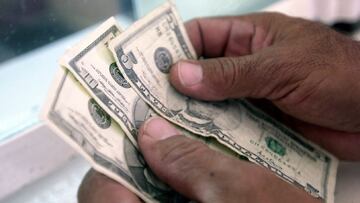Second stimulus check: what are the differences between EIP card and stimulus check?
The IRS has started distributing the second round of stimulus checks, or Economic Impact Payments although there is no similarity with the EIP card.

Last week the Internal Revenue Service (IRS) began issuing the first of the second round of stimulus payments to tax-paying Americans. Around 150 million individuals will be eligible for the one-off $600 payment which is part of the relief aid included in the $900bn Covid-19 coronavirus aid package which was signed off by president Trump on 28 December.
The package provides individuals with a check of up to $600 – this time, families will also able to claim an additional $600 for child dependents aged 16 or under. Those who earned under $75,000 in the 2019 tax year will get the full stimulus check, while smaller amounts, staggered in relation to income, will be given to people on a higher annual income, up to a maximum phase-out limit of $87,000.
Do I have to pay tax on my second stimulus check?
Has the American healthcare system collapsed?
Stimulus check payments begin, make sure your IRS details are correct
Payments in this second round of relief aid are known as Economic Impact Payments although there is no similarity with the EIP prepaid debits card which were issued to some individuals back in May. The IRS has no plans to distribute EIP debit cards in this new round of payments however some citizens who have specifically chosen to have their payment on an EIP debit card will be sent a new EIP 2 card. In general, those who did receive their first stimulus check on an EIP card will not have their card “reloaded” – unless they have requested to do so.
The majority of the second round of $600 Economic Impact Payments will be made in two ways - by paper check which will be mailed to the address which is on file at IRS via the US Postal Service. Another way that individuals could receive their payment is by direct deposit into their personal bank account.
In a press release issued today, the IRS explained, "Paper checks also began going out and will continue to be sent through January. Some people will be mailed debit cards in January, and the IRS urges people to carefully check their mail. Mailed payments will require more processing and mailing time. Those who reside abroad will have longer wait times for checks as disruptions to air travel and mail delivery in some countries will slow delivery. We emphasize that there is no action required by eligible individuals to receive this second payment. The payments are automatic, and people should not contact their financial institutions or the IRS with payment timing questions".
#IRS is delivering a second round of Economic Impact Payments to millions of Americans. There’s no need for taxpayers to take any action, call the IRS or their financial institution. See https://t.co/VY0F1xzGPl #COVIDreliefIRS pic.twitter.com/ZE3TWzL52H
— IRSnews (@IRSnews) January 4, 2021
Payments via EIP 2 debit cards
Related stories
The new EIP 2 cards will work in exactly the same way as the previous ones which were received by around four million Americans for whom the IRS did not have up-to-date bank information for. EIP cards are basically the same as debit cards that you can spend like cash or use to transfer the funds to your bank. They can be used to make purchases wherever a debit card is accepted, withdraw cash from ATMs and transfer the stimulus funds to any account the holder wants without a fee. To use an EIP 2 card, first it must be activated by phone to establish your own, private, personal pin number. Once you have your pin number and have signed your name on the reverse, you can start using the card - they will however, probably have an expiry date.
Some people who are receiving benefits which are directly deposited to a Direct Express card may have their Economic Impact Payments deposited onto that card. The bank information shown in Get My Payment will be a number associated with your Direct Express card and may be a number you don’t recognize. If you are in any doubt about your stimulus payment or want to find out where it is or when you might receive it, you can get updates through the Get My Payment portal. Data is updated once per day overnight, so there's no need to check more than once per day.

